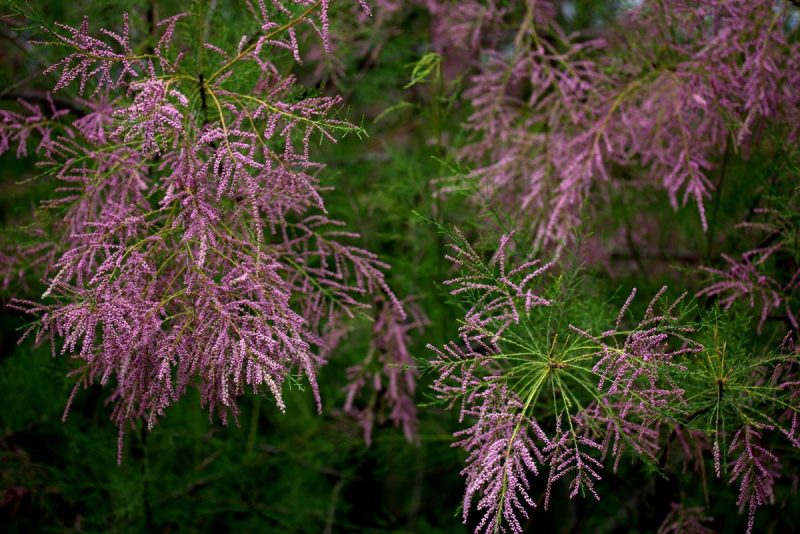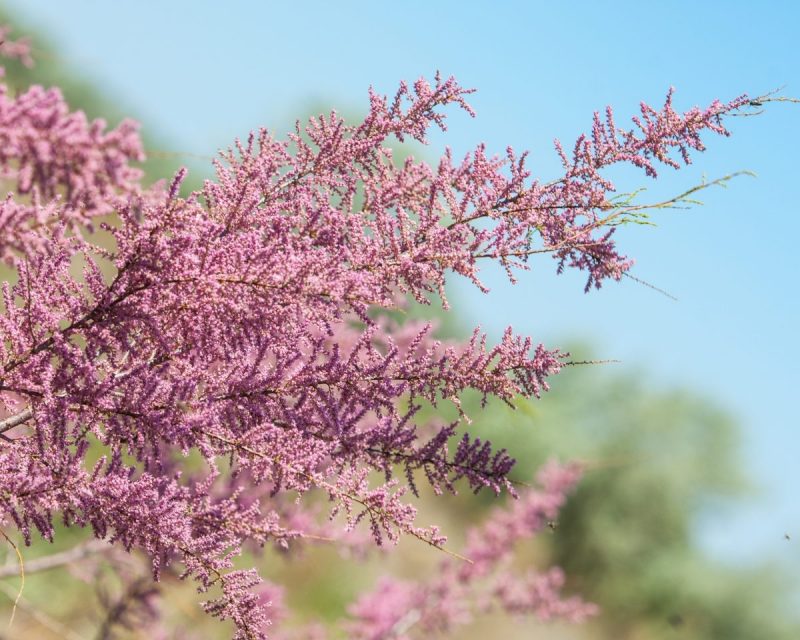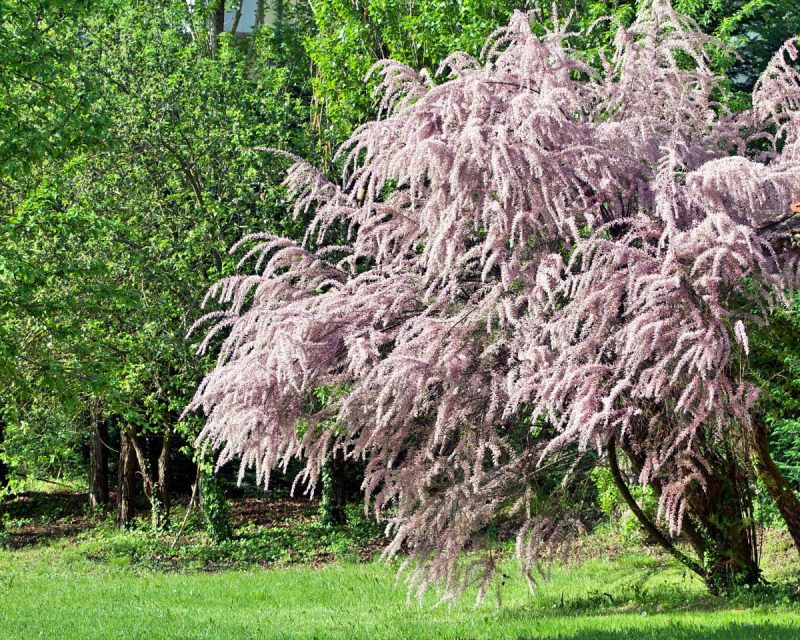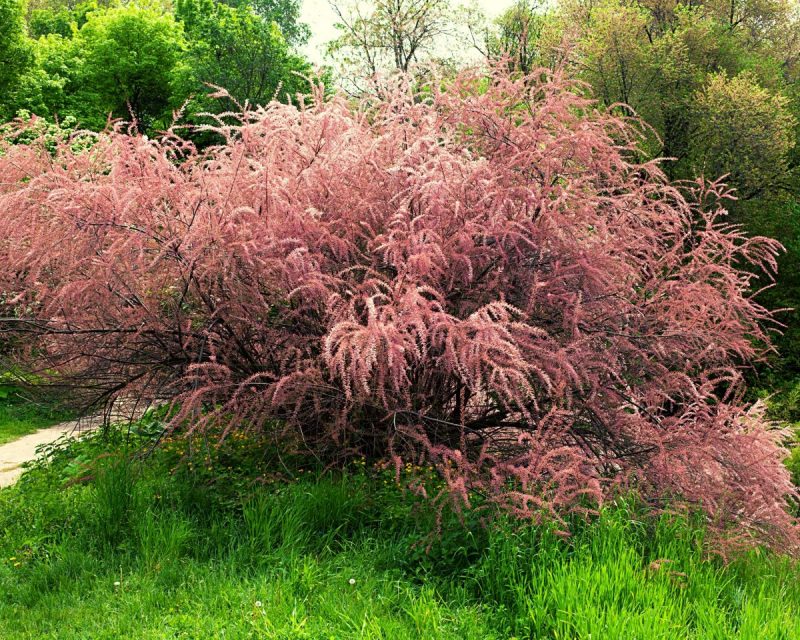Tamarisk, planting guide and care work

Tamarisk (Tamarix spp.), popularly called salt cedar, is a species of flowering shrub, native to Europe, Asia and Africa. Tamarisk is cultivated for its attractive, small, scale-like leaves and pale pink or rosy flowers, arranged in racemes. The shrub blooms in spring, summer or early autumn, depending on the species.
In regions with mild winters it can become an invasive species. In regions with harsher winters, it is grown in gardens and parks, being resistant to strong winds. Tamarisk is also found as a hedge, in the areas by the sea.
Tamarisk – types
- Tamarix aphylla: a shrub with grey-green, scale-like leaves. The flowers are small, pink or white, blooming from March to September. It can reach a height of up to 4 meters;
- Tamarix parviflora: with small, pink flowers that appear at the end of spring;
- Tamarisk pentandra: the leaves are dark in color and the flowers are pink, slightly fragrant;
- Tamarix tetrandra: the flowers are pale pink, they form in spring, before the leaves. It can reach a height of 4.5 meters.



Environmental conditions
Light. To bloom, it needs to be planted in areas where it can benefit from direct sunlight.
Temperature. It is a species resistant to high or low temperatures. However, it can be affected by temperatures below -5℃.
Soil. It does not have high demands in terms of soil. It can be grown on clayey, sandy or saline soils. However, poorly drained and calcareous soils should be avoided.
Tamarisk – care
Watering. The plants need to be watered moderately, being resistant to drought. Young plants are watered more often, especially after planting.
Fertilizing. It reacts favorably to the application of fertilizers. Fertilizers specially formulated for decorative trees and shrubs can be used.
Recommended products
-
You can find products on a different store
Change Store -
You can find products on a different store
Change Store -
You can find products on a different store
Change Store -
You can find products on a different store
Change Store -
You can find products on a different store
Change Store -
You can find products on a different store
Change Store -
You can find products on a different store
Change Store -
You can find products on a different store
Change Store -
You can find products on a different store
Change Store -
You can find products on a different store
Change Store -
You can find products on a different store
Change Store -
You can find products on a different store
Change Store -
You can find products on a different store
Change Store -
You can find products on a different store
Change Store -
You can find products on a different store
Change Store -
You can find products on a different store
Change Store -
You can find products on a different store
Change Store -
You can find products on a different store
Change Store -
You can find products on a different store
Change Store -
You can find products on a different store
Change Store -
You can find products on a different store
Change Store -
You can find products on a different store
Change Store -
You can find products on a different store
Change Store -
You can find products on a different store
Change Store
Pruning. It is carried out to keep a compact shape of the shrub and to stimulate flowering. For late-flowering species, pruning can be carried out at the beginning of spring, and for early-flowering species, immediately after flowering.
Recommended products
-
You can find products on a different store
Change Store -
You can find products on a different store
Change Store -
You can find products on a different store
Change Store -
You can find products on a different store
Change Store -
You can find products on a different store
Change Store -
You can find products on a different store
Change Store -
You can find products on a different store
Change Store -
You can find products on a different store
Change Store -
You can find products on a different store
Change Store -
You can find products on a different store
Change Store -
You can find products on a different store
Change Store -
You can find products on a different store
Change Store -
You can find products on a different store
Change Store -
You can find products on a different store
Change Store -
You can find products on a different store
Change Store -
You can find products on a different store
Change Store -
You can find products on a different store
Change Store -
You can find products on a different store
Change Store -
You can find products on a different store
Change Store -
You can find products on a different store
Change Store -
You can find products on a different store
Change Store -
You can find products on a different store
Change Store -
You can find products on a different store
Change Store -
You can find products on a different store
Change Store
Propagation. It is propagated by semi-lignified cuttings or by seeds.
Planting. The optimal period for planting is autumn or spring, during dormancy.
Diseases and pests
It is prone to powdery mildew and root rot. Plants with affected roots need to be removed and destroyed by burning.
Recommended products
-
You can find products on a different store
Change Store -
You can find products on a different store
Change Store -
You can find products on a different store
Change Store -
You can find products on a different store
Change Store -
You can find products on a different store
Change Store -
You can find products on a different store
Change Store -
You can find products on a different store
Change Store -
You can find products on a different store
Change Store -
You can find products on a different store
Change Store -
You can find products on a different store
Change Store -
You can find products on a different store
Change Store -
You can find products on a different store
Change Store -
You can find products on a different store
Change Store -
You can find products on a different store
Change Store -
You can find products on a different store
Change Store -
You can find products on a different store
Change Store -
You can find products on a different store
Change Store -
You can find products on a different store
Change Store -
You can find products on a different store
Change Store -
You can find products on a different store
Change Store -
You can find products on a different store
Change Store -
You can find products on a different store
Change Store -
You can find products on a different store
Change Store -
You can find products on a different store
Change Store















































































































































































































































































































































































































































